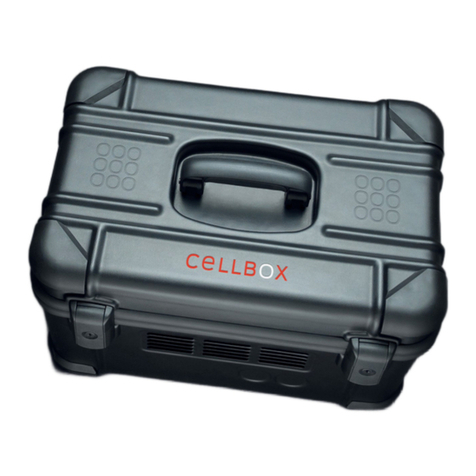
the ADR (European Agreement concerning the Interna-
tional Carriage of Dangerous Goods by Road, applicable
as from 01.01.2015) as well as Class 3.6.2 of the IATA
(International Air Transport Association - Dangerous
Goods Regulations, applicable as from 01.01.2021).
Use of the device for any purpose other than the in-
tended purpose described in section 4.1 is classified as
misuse and can result in danger or damage.
The device may not be used for the transport of materials
and substances that could produce toxic vapors or ex-
plosive fumes at the set temperature. Furthermore, ma-
terials and substances that pose a risk of exploding,
bursting or igniting may not be transported in this device.
If any doubt arises about the composition of the materials
or substances to be transported, they must not be
loaded in the device.
Potentially explosive gas-air mixtures may not be formed
in the transportation compartment, nor may the device
be operated in their immediate vicinity.
5SAFETY INSTRUCTIONS
The device may only be operated in a good work-
ing order. When the user identifies any irregularities, dis-
turbances or damage before or during the operation of
the device, it should immediately be decommissioned.
After decommissioning the device, the user should con-
tact the manufacturer.
The device may not be rebuilt, modified or altered
in any way without the authorization of the manufacturer.
In the event of any unauthorized modification or altera-
tion, the declaration of conformity is declared invalid and
the device must be decommissioned.
During the transport of unsuitable goods, the pos-
sibility exists that toxic vapors or explosive fumes may be
formed. This may cause the device to explode and result
in serious injury or poisoning. The device is only intended
for the transport of goods that do not form any toxic va-
pors or explosive fumes when heated (also see section
4)
The device must not be sprayed with or sub-
merged in water. As the device is only resistant to low
quantities of dripping water, larger quantities of water
could reach the internal electronics and cause damage.
As a result of partial disassembly or damage to
the casing of the trunk, electrical wires could be exposed
and pose a risk of electric shock to the user. Repairs and
maintenance of the electric components must only be
performed by the manufacturer and authorised partners.
The use of the device in potentially
explosive areas (containing flammable
substances, gases, fumes or mixtures of gas and
air) is strictly forbidden. The device does not have
any measure of explosion protection.
Only use the Cellbox Flight 2.0 in well
ventilated areas when filled with dry ice. Due to
the sublimation of dry ice an increase of the CO2
concentration can ensue in the environment
around the device. Depending on the CO2
concentration inhaled and exposure duration,
toxicological symptoms in humans could range
from headaches increased respiratory and heart
rate, dizziness, muscle twitching, confusion,
unconsciousness, coma and death.
6 PRODUCT SPECIFICATION
6.1 Scope of Delivery
Besides the Cellbox Flight 2.0 the following items are in-
cluded in the scope of delivery:
•1x multi-well holder
•3x spacers for multi-well holder
•1x power adapter for operation of the device or for
charging the battery packs
•1x car adapter
•Technical Manual (Online)
•Power plugs with wall socket compatibility for
EU, Japan, UK, USA, Switzerland and Australia.
6.2 Installation
Place the polystyrene carton overpack for best ergonom-
ics onto a clean floor. Open the carton as well as the
isolating polystyrene lid. Pull the lid handle and lift the
Cellbox 2.0 out of its isolating overpack with care and




























